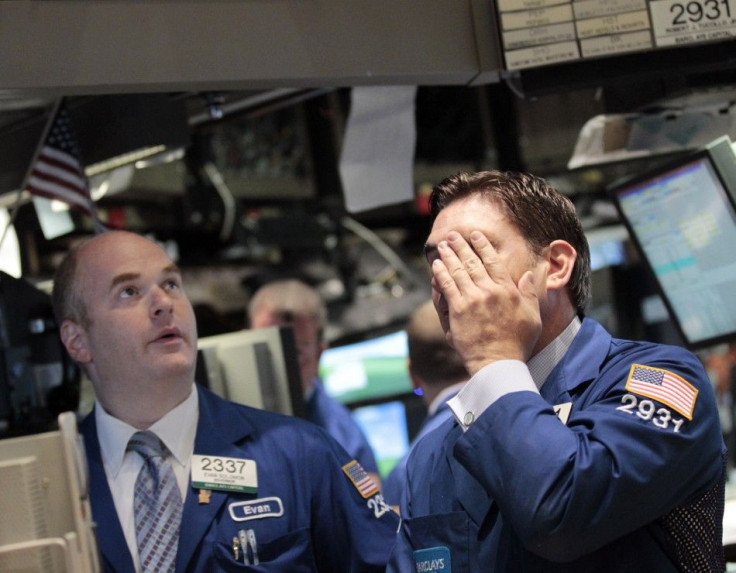Is U.S. Heading For Another Recession?

Stocks tumbled across the globe on Thursday amid growing worries about the U.S. economy and Europe's mounting debt problems, reviving fears of another deep recession. However, a better-than-expected jobs report brought back some hope in the markets.
Currently, Dow Jones Industrial Average and S&P 500 were up 0.23 percent and 0.03 percent. Nasdaq is still down 1.2 percent.
On Thursday, more than 14 billion shares changed hands, marking it as the most furious selling day in over a year.
"Well, while the sell off was not completely unexpected as we have been discussing and warning for several weeks now -- the size and magnitude of the one day sell off was a bit surprising," Lance Roberts of Streettalk Advisors wrote on a blog post.
"As the rest of the economists and analysts now play catch up to where we have been positioned since late last year that a recession was not only a likelihood but a definite reality, barring further intervention by the Federal Reserve, the market trading robots went ballistic as one technical break after another triggered more and more aggressive selling as the algorithms lost complete control" Roberts said.
The Dow and the S&P 500 plunged more than 4 percent on Thursday and the Nasdaq lost 5 percent. The Dow Jones Industrial Average plunged 4.31 percent to 11,383.68, the S&P 500 dropped 4.78 percent to 1,200.07 and the tech-heavy Nasdaq tumbled 5.08 percent to 2,556.39.
European stock markets declined to 14-month lows on Friday, following a global rout, as investors awaited a jobs report for clues on economic outlook.
DAX30 declined 2 percent to 6,283.73, FTSE 100 fell 2.20 percent to 5,274.50, and CAC 40 dropped 0.35 percent to 3,307.90.
In Asia, Tokyo shares tumbled to their lowest since the post-quake rout in March. Benchmark Nikkei plunged 3.72 percent to 9,299.88.
Hong Kong's Hang Seng index plunged 4.29 percent to 20,946.14, China's Shanghai composite declined 2.15 percent to 2,626.42 and Seoul composite tumbled 3.70 percent to 1,943.75.
However, a better-than-expected jobs report brought back the much-needed optimism in the markets.
The U.S. economy unexpectedly added 117,000 jobs in July and nation's unemployment rate dipped to 9.1 percent from 9.2 percent, the U.S. Labor Department announced on Friday. Analysts expected payrolls to increase by 85,000 and the jobless rate to remain at 9.2 per cent.
The U.S. economy needs at least 100,000 new jobs per month to keep pace with the expansion of the labor market. It needs a lot more than that to lower the unemployment rate and keep climbing out of the Great Recession. The gain in jobs was just 18,000 in June and 54,000 in May.
Barring the jobs report, all the latest developments, including Obama signing to lift the debt ceiling, and the Commerce Department reporting much slower-than-expected growth, signal that the U.S. could be heading deeper into recession.
On Tuesday, President Barack Obama signed a bill to raise the U.S. debt ceiling, preventing the nation from defaulting for the first time in its history. The agreement passed by Congress provides for an initial increase of the debt limit of $900 billion and introduces procedures that would allow the limit to be raised further in two additional steps, for a cumulative increase between $2.1 trillion and $2.4 trillion by the end of 2011.
The U.S. economy also stumbled badly in the first half of 2011 and came dangerously close to contracting in the January-March period. The economy grew at a 1.3 percent annual pace in the second quarter, compared to the 1.9 percent that the analysts were expecting.
Additionally, growth for the first quarter was revised down to 0.4 percent from the previously reported 1.9 percent rise. As a result of this slower-than-expected expansion, economists' expectations for the fourth quarter dropped to 2.3 percent from 3.1 percent.
Whenever the stock market plunges for several days it reminds us the stock market crash in October 1929, which triggered the 12-year great depression that hit all the western industrialized nations. It all began on a "Black Thursday", Oct. 24, 1929, when share prices on the New York Stock Exchange collapsed. Stock prices plummeted on that day, and continued to fall at an unprecedented rate for a full month.
Currently, all three major U.S. indices have now erased all gains made during the year. Over the past ten days, U.S. indices have fallen more than 10 percent. The 4.78 percent slide for the S&P 500 was the worst such drop since Jan. 20, 2009, when it fell 5.28 percent.
It was the Index's biggest single-day point loss since Dec. 1, 2008, when the Dow plunged 679.95 points at the height of the financial crisis.
"The damage this week is more than last week -- translation, more damage from economic fears than debt fears," said Howard Silverblatt, senior index strategist at S&P.
Lance Roberts of Streettalk advisors agreed and said "there is nothing more certain the QE3 and the potential for another recession. The trend of the data is all negative, so barring any quantitative easing program from the Fed, we will probably be in a recession by the end of the year."
Another economist differs from the view and said there is only 50 percent chance of U.S. economy slumping in to recession.
"This economy is really balanced on the edge. There's now a 50 percent chance that we could slide into a new recession. Nothing has given us much growth," Harvard University economics professor Martin Feldstein said in an interview on Bloomberg Television.
© Copyright IBTimes 2024. All rights reserved.



















